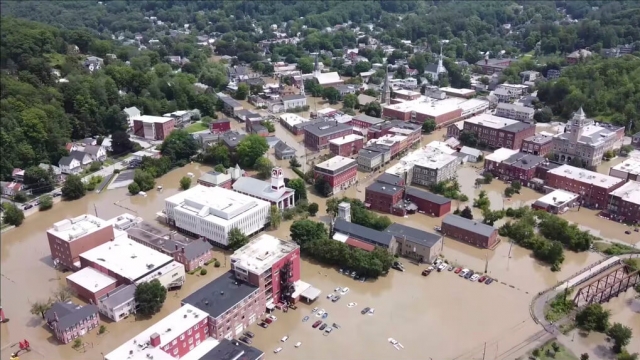ST. PETERSBURG, Fla. — As the Northeast deals with those floods down in Florida, we here in Tampa Bay are feeling the extreme heat.
Last week, we told you it was the hottest Fourth of July on record in Tampa Bay. That same week, we saw a global record broken for temperatures.

When you think of Florida, you think of two things: sunshine and water.
But what fills us with so much pride is also what makes us vulnerable, according to the University of South Florida Associate Dean in the College of Marine Science Gary Mitchum.
"Think about a sponge. When the temperature is 70 degrees, the sponge is this big, and you can squeeze it. When the temperature is 95 degrees, the sponge is this big, and when you squeeze it, you get a lot more water out," he explained.
Mitchum explains those hot days are just the start of the impacts of climate change.
Like the sponge, record-breaking heat can often turn into heavy rain storms.
"Our stormwater system isn't built to handle that volume of water in that amount of time. So that's why we see the street flooding is getting worse and worse with just what looks like a normal rainstorm. Those are going to become more frequent," he explained.
The City of Tampa is tackling the issue. This summer, the City released its first Climate Action and Equity Plan. The plan outlines 143 initiatives to make the city more sustainable and resilient.

The city's Sustainability and Resilience Officer Mitch Remer explains that the plan includes hundreds of millions of dollars invested in improving stormwater systems to prevent flooding.
"We know that these rainstorms are dropping a lot more rain at once. And so we're making sure that those pipes and the stormwater ponds can handle that," he explained. "But then, in addition to that, making sure that if we are creating new stormwater ponds, or renovating them so that they might be re-imagined to somewhere where people can go and recreate when it's not full of stormwater. "
The city's plan also pinpoints other areas of climate change, like renewable energy.
"[These] solar panels [are] a 150-kilowatt display, and it will power about 80% of this building's energy use when it's finished. This building uses about $100,000 worth of electricity every year. And so when we're not spending that money on electric bills, we can spend it on other things like programs for the children," he said.
Increased rainfall is just one way we're seeing climate change in the form of water.
"Sea level has been rising for a long time. And the problem is that as the planet's surface temperature is warming, that the sea level rise is accelerating. We're getting more and more each year. So whereas it took a close to 100 years to get a foot, we're now talking about a foot in the next 30, 40 years," Mitchum explained.
Joana Huxster, Associate Professor of Environmental Studies at Eckerd College, preaches adaptation.
Whether it's retreating further from the water or taking better care of the natural tools at our disposal.
"We have some great access to living shorelines here. So things like mangroves and oyster beds and oyster reefs can actually help absorb the impact and absorb the force of the water coming in so that when you have a storm, or when you have sea level rise, the impact of the water won't be as harsh," said Huxster. "We tend to sort of think towards things like sea walls and hard structures. But those actually hold back the water for a while. But when they break, you end up with more velocity. And so it's actually better to have these sort of soft shorelines, and they're also better for the ecosystems, and they look nice."

We asked Huxster if there's validity to the common idea that Florida will end up underwater in the future.
"None of the very worst outcomes are set in stone. We have the ability to mitigate our impact and to lessen how much it warms. But we can't guarantee that we're going to do that. So we do have to adapt as well. If we don't do anything, then yes, Miami, in particular, and southern Florida are in trouble. They are likely to be underwater," she said.
But all three tell me the future isn't bleak. Science, the government, and the everyday person is evolving, caring, and hopefully saving the state.
"People are recognizing it now. 20 years ago, 30 years ago, when I started in this, no one paid any attention to it at all. Now we recognize the problem; we're starting to adapt. That's a very positive sign," said Mitchum.
Associate Dean Mitchum also pointed out the Resilient Florida Act. It created the Florida Flood Hub housed in the College of Marine Science. The main focus is to assess future flooding, flood risk, and sea level.





